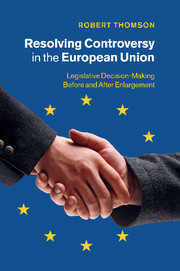 Resolving Controversy in the European Union
Resolving Controversy in the European Union Book contents
- Frontmatter
- Contents
- Figures
- Tables
- Acknowledgements
- 1 Introducing the political system of the European Union
- 2 Research design: measuring controversy spatially
- Part I Inputs
- 3 The European Union’s political space
- 4 The European Commission’s policy positions
- 5 The European Parliament’s policy positions
- 6 Member states’ policy positions
- Part II Processes
- Part III Outputs
- 12 Evaluating and improving the European Union
- Appendix The selection of legislative proposals
- References
- Index
3 - The European Union’s political space
from Part I - Inputs
Published online by Cambridge University Press: 07 October 2011
- Frontmatter
- Contents
- Figures
- Tables
- Acknowledgements
- 1 Introducing the political system of the European Union
- 2 Research design: measuring controversy spatially
- Part I Inputs
- 3 The European Union’s political space
- 4 The European Commission’s policy positions
- 5 The European Parliament’s policy positions
- 6 Member states’ policy positions
- Part II Processes
- Part III Outputs
- 12 Evaluating and improving the European Union
- Appendix The selection of legislative proposals
- References
- Index
Summary
This chapter describes the inputs into the legislative process. These inputs consist of the policy demands made by the main actors – the Commission, the European Parliament (EP) and member states’ representatives in the Council – on controversies raised by legislative proposals. The following three descriptive questions are addressed in this chapter:
To what extent are there patterns in the alignments of actors’ policy positions across a range of controversies?
To the extent that these patterns exist, what are they?
Do these patterns tend to emerge on particular types of controversies?
Before attempting to explain a phenomenon, which Chapters 4–6 do with respect to different actors’ policy demands, it is necessary to describe it systematically. With the benefit of good description, the explanatory analysis can focus on the most salient features of actors’ policy positions. Chapters 4–6 are based on some key insights from the present chapter. This chapter identifies a number of interesting patterns in the alignments of actors’ policy positions, but the main descriptive finding is that actors’ positions vary considerably across different controversial issues. This is true of variation in the positions of the two supranational actors, the Commission and EP, and of the positions of member states’ representatives.
- Type
- Chapter
- Information
- Resolving Controversy in the European UnionLegislative Decision-Making before and after Enlargement, pp. 51 - 78Publisher: Cambridge University PressPrint publication year: 2011


